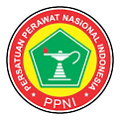Optimization of Whole Blood Specimen Handling for Complete Blood Count (CBC) Results and Blood Cell Morphology
DOI:
https://doi.org/10.26630/jk.v16i2.5126Keywords:
Anticoagulant, Complete blood count, Delay time, Blood cell morphology, Whole bloodAbstract
Hematology analyzers are used in almost all clinical laboratories for CBC testing. CBC test results are crucial, as they play a significant role in establishing diagnoses and determining the appropriate therapy for patients. This study aims to analyze the effect of anticoagulant type, storage temperature, and delay time on the results of erythrocyte, leukocyte, and thrombocyte counts in whole blood samples. The study design employed was a laboratory experiment with a total of 64 samples, which were subjected to a combination of treatments involving anticoagulant type (Vacutainer and conventional), storage temperature (room temperature and refrigerator), and delay time for testing (0, 6, 12, and 24 hours). The examination was conducted using a hematology analyzer, and data analysis was performed using the Kruskal–Wallis test and the post hoc Mann–Whitney U test. The results showed that there was no significant effect of the three factors on the number of erythrocytes and leukocytes. However, the delay time significantly affected the platelet count (p=0.004), with significant differences observed between 6 hours and 24 hours, and between 12 hours and 24 hours. The delay in blood examination with K3EDTA and Na2EDTA affects the morphology of erythrocytes and leukocytes. Abnormal changes occur after 6, 12, and 24 hours of storage. The gold standard is a fresh whole blood sample collected in a K3EDTA vacutainer tube with the correct volume and analyzed within a maximum of 2 hours at room temperature.
References
Afriansyah, F., Bastian, B., Sari, I., & Juraijin, D. (2021). Pengaruh Lamanya Penyimpanan dan Suhu terhadap Jumlah Eritrosit. Journal of Indonesian Medical Laboratory and Science (JoIMedLabS), 2(2), 108–114. https://doi.org/10.53699/joimedlabs.v2i2.51
Agistriany, R., Hayati, E., Nurhayati, B., Durachim, A., Studi, P., Terapan, S., Teknologi, J., Medis, L., & Bandung, K. K. (2024). Pengaruh Lama Simpan Darah dan Jenis Antikoagulan terhadap Nilai Neutrophil Lymphocyte Ratio pada Wanita dengan Kanker Payudara. Jurnal Kesehatan Siliwangi, 951–959. ht
Darmadi, & Permatasari, D. (2018). Perbedaan Jumlah Leukosit Darah Edta Diperiksa Segera Dan Ditunda 2 Jam. Klinikal Sains : Jurnal Analis Kesehatan, 6(2), 30–36. http://jurnal.univrab.ac.id/index.php/klinikal/article/view/578
Dewi, L. S., Sudarsono, T. A., & Sulistiyowati, R. (2022). Perbandingan Hasil Pemeriksaan Hitung Jumlah Eritrosit Menggunakan EDTA Konvensional dan Vacutainer. Jurnal Surya Medika, 7(2), 181–184. https://doi.org/10.33084/jsm.v7i2.2842
Handini, F. A., & Dewi, R. K. (2022). Jurnal review: pengaruh suhu dan waktu penyimpanan sampel darah terhadap pemeriksaan hitung jumlah trombosit. Repository Universitas ’Aisyiyah Yogyakarta, 73.
Hasan, Z. A., Arif, M., & Bahrun, U. (2017). Variasi Perlakuan Penanganan Sampel Serum dan Pengaruhnya Terhadap Hasil Pemeriksaan Kreatinin Darah. JST Kesehatan, 7(1), 72–78.
Jaya, A., Kakkar, N., & John, Mj. (2022). Effect of Room Temperature and Refrigerated Storage on Automated Complete Blood Count: A Longitudinal Study. CHRISMED Journal Of Health and Research, 9(1), 57–61. https://doi.org/10.4103/cjhr.cjhr_140_20
Kadam, P., Patil, N., & Mane, V. P. (2023). Study of refrigerated storage of blood at 4°C on automated hematological parameters & morphological changes in peripheral blood smear: A prospective study. Indian Journal of Pathology and Oncology, 10(1), 9–14. https://doi.org/10.18231/j.ijpo.2023.003
Kementerian Kesehatan Republik Indonesia. (2022). Profil Kesehatan Indonesia. Kementerian Kesehatan Republik Indonesia. Jakarta.
Kuman, M. Y. (2019). Perbedaan Jumlah Eritrosit, Leukosit dan Trombosit pada Pemberian Antikoagulan EDTA Konvensional dan EDTA Vacutainer. Politeknik Kesehatan Kemenkes Kupang.
McPherson, R. A., & Pincus, M. R. (2011). Henry’s Clinical Diagnosis and Management by Laboratory Methods. ELSEVIER. https://doi.org/10.1016/b978-1-4377-0974-2.00017-8
Naz, S., Mumtaz, A., & Sadaruddin, A. (2012). Preanalytical Errors and their Impact on Tests in Clinical Laboratory Practice. Pakistan Journal of Medical Research, 51(1), 27–30.
Nugraha, G., Ningsih, N. A., Sulifah, T., & Fitria, S. (2021). Stabilitas Pemeriksaan Hematologi Rutin Pada Sampel Darah Yang Didiamkan Pada Suhu Ruang Menggunakan Cell-Dyn Ruby. The Journal of Muhammadiyah Medical Laboratory Technologist, 4(1), 21. https://doi.org/10.30651/jmlt.v4i1.8255
Ozmen, S. U., & Ozarda, Y. (2021). Stability of Hematologycal analytes during 48 hours storage at three temperatures using Cell-Dyn Hematology Analyzer. Journal of Medical Biochemistry, 40(3), 252–260. https://doi.org/10.5937/jomb0-27945
Palmer, L., Briggs, C., Mcfadden, S., Zini, G., Burthem, J., Rozenberg, G., Proytcheva, M., & Machin, S. J. (2015). ICSH recommendations for the standardization of nomenclature and grading of peripheral blood cell morphological features. International Journal of Laboratory Hematology, 37(3), 287–303. https://doi.org/10.1111/ijlh.12327
Pintér, E., László, K., Schüszler, I., & Konderák, J. (2016). The stability of quantitative blood count parameters using the ADVIA 2120i hematology analyzer. Practical Laboratory Medicine, 4, 16–21. https://doi.org/10.1016/j.plabm.2015.12.001
Plebani, M., Sciacovelli, L., Aita, A., & Chiozza, M. L. (2014). Harmonization of pre-analytical quality indicators. Biochemia Medica, 24(1), 105–113. https://doi.org/10.11613/BM.2014.012
Puspitasari, P., & Aliviameita, A. (2022). Stabilitas Sampel Darah Terhadap Profil Hematologi Dengan Metode Otomatis. The Journal of Muhammadiyah Medical Laboratory Technologist, 5(1), 1. https://doi.org/10.30651/jmlt.v5i1.12667
Rahmnitarini, A., Hernaningsih, Y., & Indrasari, Y. N. (2019). The stability of sample storage for complete blood count (CBC) toward the blood cell morphology. Bali Medical Journal, 8(2), 391–395. https://doi.org/10.15562/bmj.v8i2.1369
Ramya, S., Vijayambika, N., & Eswari. (2022). Effect of Room Temperature and Refrigerated Storage on Automated Complete Blood Count. CHRISMED Journal of Health and Research, 9(1), 57–61. https://doi.org/10.4103/cjhr.cjhr_140_20
Rosyidah Rudina Azimata, Aulia Tata Ningrum, W. R. (2024). Perbedaan Jumlah Leukosit Pada Darah EDTA Yang Ditunda Selama 24 Jam. Al-Asalmiya Nursing Jurnal Ilmu Keperawatan (Journal of Nursing Sciences), 13(1), 120–130. https://doi.org/10.35328/keperawatan.v13i1.2619
Sigit, W., & Aini, N. (2013). Pemeriksaan Jumlah Trombosit Menggunakan Hematologi Analyzer Dengan Pemberian Vacutainer Dan Antikoagulan EDTA (Pipet) Di Rumah Sakit Bhayangkara Jayapura. Jurnal Dinamis, 2(12).
Utami, A. P., Nurhayati, B., Noviar, G., & Durachim, A. (2019). Waktu Simpan Darah Antikoagulan K2EDTA dan K3EDTA terhadap Parameter Eritrosit. Jurnal Riset Kesehatan POLTEKKES DEPKES BANDUNG, 11(2), 1–12. https://doi.org/10.34011/juriskesbdg.v11i2.743
Wahdaniah, W., & Tumpuk, S. (2018). Perbedaan Penggunaan Antikoagulan K2EDTA DAN K3EDTA Terhadap Hasil Pemeriksaan Indeks Eritrosit. Jurnal Laboratorium Khatulistiwa, 1(2), 114. https://doi.org/10.30602/jlk.v1i2.147
Yunus, R., Astina, F., & Hasan, F. E. (2022). Qualitative Analysis of Erythrocyte Morphology in EDTA (Ethylene Diamine TetraaceticAcid) Blood Smears For immediate examination (0 hours) and delayed examination(2 hours). Borneo Journal Of Medical Laboratory Technology, 5(1), 326–334. https://doi.org/10.33084/bjmlt.v5i1.4430
Downloads
Published
Issue
Section
License
Copyright (c) 2025 Andika Aliviameita, Puspitasari, Widya Intan Amilya, Igfina El Savitra

This work is licensed under a Creative Commons Attribution-ShareAlike 4.0 International License.
Authors who publish in this journal agree to the following terms:
- Authors retain copyright and grant the journal right of first publication with the work simultaneously licensed under a Creative Commons Attribution License (CC BY-SA 4.0) that allows others to share the work with an acknowledgment of the work's authorship and initial publication in this journal.
- Authors can enter into separate, additional contractual arrangements for the non-exclusive distribution of the journal's published version of the work (e.g., post it to an institutional repository or publish it in a book), with an acknowledgment of its initial publication in this journal.
- Authors are permitted and encouraged to post their work online (e.g., in institutional repositories or on their website) prior to and during the submission process, as this can lead to productive exchanges and earlier and greater citations of published work.











